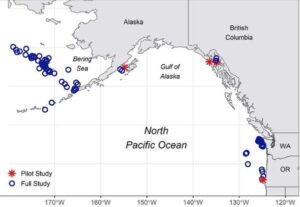Radiocarbon Dating Techniques Used to Estimate Ages.
In a new project, scientists hope to learn more about age determination and maximum lifespan of Pacific sleeper sharks. Scientists are examining the nuclear core and outer eye lens layers of this species to estimate plausible age ranges. Results of this study may offer valuable information to add to the assessment of the stock populations in Alaska, including estimating natural mortality rates.
The North Pacific Research Board is supporting this project led by Cindy Tribuzio and Beth Matta from the Alaska Fisheries Science Center to investigate ages of Pacific sleeper sharks. They’re teaming up with scientists from Lawrence Livermore National Laboratory, American River College, Woods Hole Oceanographic Institute, and others that use radiocarbon dating techniques for shark species.
“The project’s goal is to explore the alternative age determination methods for this species,” said Cindy Tribuzio, study lead investigator. “We will be using the nuclear core and layers of the eye lenses to estimate the year they are formed based on isotope levels in the core or layers.”
The results of this study are expected to provide information to the Pacific sleeper shark stock assessment, including estimating natural mortality. There is a critical need for life history information to better inform stock assessments.
“This information is something the North Pacific Fishery Management Council’s Scientific and Statistical Committee has asked for to improve how we assess and manage this species,” said Tribuzio. “However, traditional age determination methods have been unsuccessful.”
Data-Poor Species
The Pacific sleeper shark is Alaska’s largest, most mysterious shark. They are a valuable member of the deep-sea ecosystem of the North Pacific Ocean. The Pacific sleeper shark likely has slow growth, late maturity, long lifespan, and low reproductive rates, resulting in a higher risk of becoming overfished. The International Union for Conservation of Nature recently categorized these populations in the North Pacific Ocean as decreasing and “Near Threatened.”
Limited data regarding the movements, reproduction, and population size of the Pacific sleeper shark poses challenges for devising effective fisheries management strategies. Currently, bycatch limits for Pacific sleeper sharks are based on historic catch data and do not consider the biology of the species.
Preliminary radiocarbon aging of the eye lenses has indicated that the growth rate is very slow. The project proposal is supported by a pilot study that indicates strongly that the Pacific sleeper shark grows substantially faster than the Greenland shark. Greenland sharks are a closely related species with an estimated lifespan of several centuries. It can still take the Pacific sleeper shark 50 years or more to reach maturity.
“We are just scratching the surface at this large enigma,” said Tribuzio, “This is a huge step forward in advancing our knowledge of this data-poor species.”
It Takes a Village: The Important Role of Alaska Fisheries Observers in this Research

“This work would not be possible without the Observer Program,” said Beth Matta. “Collecting samples is difficult for this large species, and we rarely encounter them in our scientific surveys. However, they are sometimes caught incidentally in commercial fisheries. Fisheries observers have been instrumental in collecting samples for this special project, as have our industry partners. It takes a village to do this project.”
The North Pacific Observer Program is crucial for conserving and managing fisheries in Alaska. Each year, the program trains observers who gather catch data on fishing vessels and at processing plants. This information is essential for managing fisheries during the fishing season and for scientific purposes such as stock assessments and ecosystem studies.
Observers collect biological samples, such as shark eyeballs for this new radiocarbon dating “technique project,” says Brian Mason, training project manager at the Observer Program. “This work is crucial for stock assessments. Managers use this data to develop measures to manage fisheries and to minimize bycatch.”
Another aspect of “The Village” is that all of the samples for this study were collected opportunistically. While fisheries observers provided the vast majority of samples, samples were also provided by research surveys, members of the fishing industry, and from strandings. In all cases, the Pacific sleeper sharks were already deceased and not harvested for the purpose of this study. All of these sampling efforts were voluntary.
Crucial Project for Stock Assessments
Cindy Tribuzio leads the stock assessments for sharks in the Bering Sea, Aleutian Islands, and Gulf of Alaska. Every little bit of data expands the knowledge base and improves the Pacific sleeper shark stock assessment.
“Study findings can provide parameters for first-time use in stock assessments that will be based on age, growth, maturity, lifespan, and natural mortality,” said Tribuzio. This research can be valuable for studying other shark stocks and highlighting conservation concerns. “The tools produced in this study will be useful across species for developing age estimates for hard-to-age animals.”





